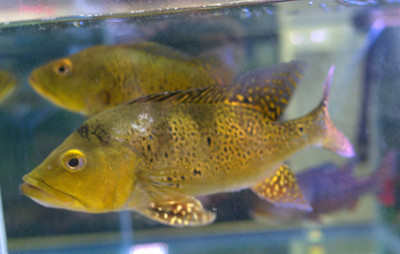Kelberi Peacock Bass: Exploring the Enigmatic Predator of South American Waters
Posted by Max Gandara on on 30th Apr 2024
Kelberi Peacock Bass: Exploring the Enigmatic Predator of South American Waters
In the labyrinthine waterways of South America, a captivating predator lurks beneath the surface, its presence marked by power, beauty, and an insatiable appetite: the Kelberi Peacock Bass. Scientifically known as Cichla kelberi, this formidable fish commands attention with its striking appearance and predatory prowess. In this article, we embark on a journey into the realm of the Kelberi Peacock Bass, uncovering its unique characteristics, habitat, behavior, and significance within the aquatic ecosystems it inhabits.
Characteristics: The Kelberi Peacock Bass is renowned for its robust physique and vibrant coloration, making it a prized catch among anglers and a captivating sight in freshwater environments. Sporting an elongated body adorned with hues of green, gold, and bronze, this predatory fish often features distinctive markings such as vertical bars or speckles, which serve as camouflage amidst its natural surroundings. Its fins are adorned with hues of red, orange, and yellow, adding to its allure as it glides through the water with grace and precision.
One of the defining features of the Kelberi Peacock Bass is its formidable mouth, equipped with sharp teeth designed for capturing and subduing prey. This predatory adaptation allows it to prey upon a diverse array of aquatic creatures, including smaller fish, crustaceans, and even small mammals or birds that venture too close to the water's edge.
Habitat and Distribution: Native to the extensive river systems of South America, the Kelberi Peacock Bass inhabits a variety of freshwater habitats, including slow-moving rivers, flooded forests, oxbow lakes, and blackwater streams. It is particularly abundant in areas with ample structure, such as submerged logs, fallen trees, and dense vegetation, which provide ideal ambush points for hunting.
While primarily found in its native range, the popularity of the Kelberi Peacock Bass among anglers has led to its introduction into other regions with suitable climates, including parts of Florida, Hawaii, and Southeast Asia. However, its status as an invasive species in some of these areas has raised concerns about its impact on native ecosystems.
Behavior and Feeding Habits: As a voracious predator, the Kelberi Peacock Bass employs stealth and agility in its pursuit of prey. It often lurks near submerged cover or along the edges of shallow flats, patiently waiting to ambush unsuspecting prey. When an opportunity arises, it launches into a lightning-fast attack, using its powerful jaws to seize its target with precision and efficiency.
In addition to its predatory prowess, the Kelberi Peacock Bass exhibits territorial behavior, particularly during the breeding season. Male specimens fiercely defend their nesting sites and vigorously protect their eggs and fry from intruders, including other fish and potential predators.
Significance to Aquatic Ecosystems: As a key player in the intricate web of South American freshwater ecosystems, the Kelberi Peacock Bass plays a crucial role in regulating the populations of its prey species and maintaining ecological balance. By controlling the abundance of smaller fish and other prey items, it helps prevent overpopulation and ensures the health and diversity of the overall ecosystem.
Furthermore, the presence of the Kelberi Peacock Bass serves as an indicator of ecosystem health, with its population dynamics reflecting the quality of its habitat and the availability of food resources. Thus, efforts to conserve and protect the natural habitats of this species benefit not only the Kelberi Peacock Bass itself but also the myriad other species that depend on healthy freshwater ecosystems for their survival.
Cultural and Economic Importance: Beyond its ecological significance, the Kelberi Peacock Bass holds cultural and economic importance for the communities that inhabit the regions where it is found. For indigenous peoples and local fishing communities, it represents a valuable food source and a traditional part of their diet. Additionally, recreational fishing for Kelberi Peacock Bass has become a popular pursuit among anglers worldwide, drawing enthusiasts to the waters where it thrives.
The growing sportfishing industry centered around the pursuit of Kelberi Peacock Bass contributes significantly to the economies of countries like Brazil, Colombia, and Peru, providing employment opportunities and supporting local businesses in remote regions. However, sustainable management practices are essential to ensure that recreational fishing activities do not negatively impact wild populations or their habitats.
Conservation Challenges and Efforts: Despite its cultural and economic significance, the Kelberi Peacock Bass faces conservation challenges, including habitat loss, overfishing, and the impacts of climate change. Deforestation, river damming, and pollution threaten the integrity of its freshwater habitats, while unregulated fishing practices can deplete local populations if not managed sustainably.
In response to these threats, conservation organizations, government agencies, and local communities are working together to implement measures aimed at protecting the Kelberi Peacock Bass and its habitat. Initiatives such as the establishment of protected areas, the enforcement of fishing regulations, and community-based conservation projects play a crucial role in safeguarding this iconic species for future generations.
The Kelberi Peacock Bass stands as a testament to the natural beauty and ecological richness of South America's freshwater ecosystems. With its awe-inspiring appearance, predatory prowess, and cultural significance, it embodies the intricate interplay between species and their environment in one of the world's most biodiverse regions. By understanding and appreciating the unique role of the Kelberi Peacock Bass, we can work together to ensure the conservation of its habitats and the preservation of its legacy for generations to come.

